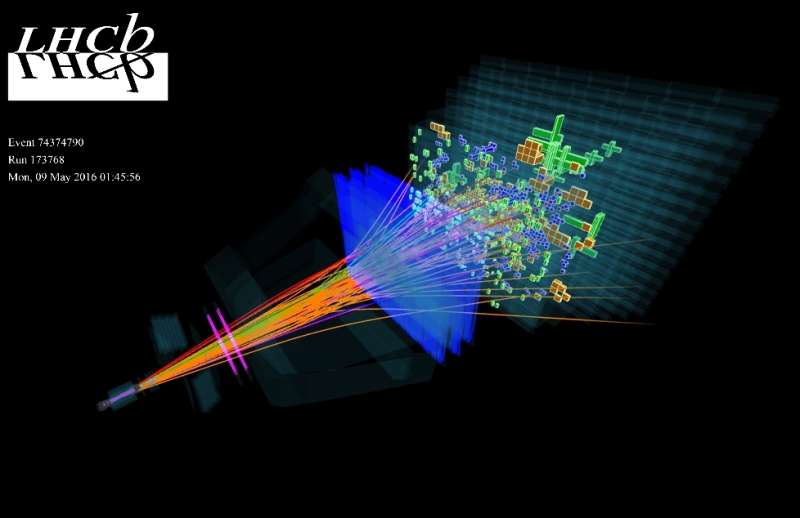Cosmic inflation: Higgs says goodbye to his 'little brother'

In the first moments after the Big Bang, the universe expanded many billions of times faster than today. Such rapid expansion is likely due to a primordial force field acting with a new particle, the inflaton. From the latest analysis of the decay of mesons carried out in the LHCb experiment by physicists from Cracow and Zurich, it appears, however, that the most probable light inflaton, a particle with the characteristics of the famous Higgs boson but less massive, almost certainly does not exist.
Just after the Big Bang, the universe probably experienced an extreme burst of expansion. If inflation did occur, there should be a new force behind it. Its force carriers are theorized to be hitherto unobserved inflatons, which should have many features reminiscent of the famous Higgs boson. Physicists from the Institute of Nuclear Physics of the Polish Academy of Sciences (IFJ PAN) in Cracow and the University of Zurich (UZH) searched for traces of light inflatons in the decay of B+ mesons recorded by detectors in the LHCb experiment at CERN near Geneva. Detailed analysis of the data, however, casts doubt on the existence of light inflatons.
Despite its weak effects, gravity influences the appearance of the universe at the greatest scales. As a consequence, all modern cosmological models are based on the best theory of gravity, Albert Einstein's General Theory of Relativity. The first cosmological models constructed on the relativity suggest that the universe was a dynamic creation. Today, we know that it was once extremely dense and hot, and 13.8 billion years ago, it began rapid expansion. The theory of relativity predicts the course of this process starting from fractions of a second after the Big Bang.
"The primary evidence of these events is the microwave background radiation that formed a few hundred thousand years after the Big Bang. It currently corresponds to a temperature of about 2.7 kelvins and uniformly fills the entire universe. It is this homogeneity that has proved to be a great puzzle," says Dr. Marcin Chrzaszcz (IFJ PAN), and explains, "When we look into the sky, the deep space fragments visible in one direction may be so distant from those visible in another direction that light has not yet had time to pass between them. So nothing that has happened in one of these areas should affect the other. But wherever we look, the temperature of distant regions of the cosmos is almost identical. How could it have become so uniform?"
The uniformity of microwave background radiation is explained by the mechanism proposed by Alan Guth in 1981. In his model, the universe initially expanded slowly, and all points observed today had time to interact and level out the temperature. According to Guth, at some point, however, there must have been a very short but extremely rapid expansion of space-time. The new force responsible for this inflation expanded the universe to such an extent that today, it exhibits a remarkable uniformity (as far as the temperature of the cosmological microwave background is concerned).
"A new field always means the existence of a particle that is the carrier of the effect. Cosmology has thus become interesting for physicists examining phenomena at the microscale. For a long time, a good candidate for the inflaton appeared to be the famous Higgs boson. But in 2012, the Higgs was finally observed in the European LHC accelerator, and turned out to be too heavy. If Higgs, with its mass, was responsible for inflation, today's relict radiation would look different than what is currently observed by the COBE, WMAP and Planck satellites," says Dr. Chrzaszcz.
Theoreticians proposed a solution to this surprising situation: The inflaton might be a completely new particle with the properties of Higgs, but with a smaller mass. In quantum mechanics, the identical nature of characteristics causes particles to oscillate—they cyclically transform one into another. An inflation model constructed in this way would have only one parameter describing the frequency of oscillation/transformation between the inflaton and the Higgs boson.
"The mass of the new inflaton could be small enough for the particle to appear in the decay of B+ mesons. And these beauty mesons are particles recorded in large number by the LHCb experiment at the Large Hadron Collider. So we decided to look for decay of mesons happening through the interaction with the inflaton in the data collected in the LHC in 2011 to 2012," says PhD student Andrea Mauri (UZH).
If light inflatons actually existed, the B+ meson would sometimes decay into a kaon (K+ meson) and a Higgs particle, which would convert into an inflaton as a result of the oscillation. After traveling a few metres in the detector, the inflaton would decay into two elementary particles: muons and antimuons. Detectors of the LHCb experiment would not record the presence of either the Higgs or the inflaton. Researchers from the IFJ PAN, however, expected to see the emission of kaons and the appearance of muon-antimuon pairs respectively.
"Depending on the parameter describing the frequency of the inflaton-Higgs oscillation, the course of B+ meson decay should be slightly different. In our analysis, we were looking for decays of up to 99 percent of the possible values of this parameter—and we found nothing. We can therefore say with great certainty that the light inflaton simply does not exist," says Dr. Chrzaszcz.
Theoretically, low-mass inflatons may still be hidden in 1 percent of the unexamined variations in oscillation. These cases will eventually be excluded by future analyses using newer data that is now being collected at the LHC. However, physicists have to reconcile the idea that if inflatons exist, they are either more massive than previously believed, or they occur in more than one variation.
More information: R. Aaij et al, Search for long-lived scalar particles in B+→K+χ(μ+μ−) decays, Physical Review D (2017). DOI: 10.1103/PhysRevD.95.071101
Journal information: Physical Review D
Provided by Polish Academy of Sciences




















